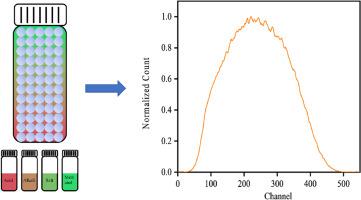利用塑料闪烁微球测量各种溶液中的β-核素
IF 5.7
2区 化学
Q1 CHEMISTRY, ANALYTICAL
引用次数: 0
摘要
背景在β核素液体闪烁分析中,闪烁鸡尾酒不能直接测量酸碱度极高的样品。结果这项研究评估了塑料闪烁微球在各种化学环境中的性能,包括四种酸(硝酸、盐酸、硫酸和磷酸)、一种碱性溶液(NaOH)、一种高盐度溶液和甲醇。PSm 与大多数溶液形成稳定的混合物,在高浓度 NaOH 溶液中表现出极佳的化学稳定性,化学发光干扰极小。然而,浓硝酸和浓硫酸会与 PSm 发生化学反应,导致变色和潜在的淬色。使用超纯水进行了效率校准,只需进行简单的效率校正,即可准确测量不同溶液中的 14C 活性。PSm 在高酸性、高碱性和高盐度条件下的稳定性使其成为放射性废物监测和药代动力学研究等应用领域的理想工具,为传统闪烁鸡尾酒提供了可靠而高效的替代品。本文章由计算机程序翻译,如有差异,请以英文原文为准。


Measurement of β-nuclides in various solutions using plastic scintillation microspheres
Background
Scintillation cocktails cannot directly measure samples with extreme acidity or alkalinity in β-nuclide liquid scintillation analysis. Plastic scintillation microspheres (PSm), as a novel scintillation material, offer the potential to overcome these limitations by allowing direct mixing with a variety of solutions for measurement, particularly in challenging chemical environments.
Results
This study evaluated the performance of PSm in various chemical environments, including four acids (nitric, hydrochloric, sulfuric, and phosphoric acids), an alkaline solution (NaOH), a high-salinity solution, and methanol. PSm formed stable mixtures with most solutions and exhibited excellent chemical stability in high-concentration NaOH, with minimal chemiluminescence interference. However, concentrated nitric and sulfuric acids caused chemical reactions with PSm, leading to discoloration and potential color quenching. Efficiency calibration was performed using ultrapure water, allowing for accurate measurement of 14C activity across different solutions with simple efficiency corrections.
Significance
The findings of this study highlight the advantages of PSm for β-nuclide measurement in a variety of complex chemical environments. PSm's stability in highly acidic, alkaline, and saline conditions makes it a promising tool for applications such as radioactive waste monitoring and pharmacokinetic research, providing a reliable and efficient alternative to conventional scintillation cocktails.
求助全文
通过发布文献求助,成功后即可免费获取论文全文。
去求助
来源期刊

Analytica Chimica Acta
化学-分析化学
CiteScore
10.40
自引率
6.50%
发文量
1081
审稿时长
38 days
期刊介绍:
Analytica Chimica Acta has an open access mirror journal Analytica Chimica Acta: X, sharing the same aims and scope, editorial team, submission system and rigorous peer review.
Analytica Chimica Acta provides a forum for the rapid publication of original research, and critical, comprehensive reviews dealing with all aspects of fundamental and applied modern analytical chemistry. The journal welcomes the submission of research papers which report studies concerning the development of new and significant analytical methodologies. In determining the suitability of submitted articles for publication, particular scrutiny will be placed on the degree of novelty and impact of the research and the extent to which it adds to the existing body of knowledge in analytical chemistry.
 求助内容:
求助内容: 应助结果提醒方式:
应助结果提醒方式:


